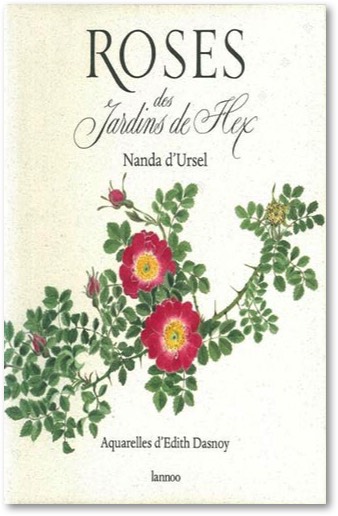
Musings » Roses des Jardins de Hex


Tielt, Belgium
Editions Lannoo 1995
Patricia Duggan generously lent me her treasured copy of this exquisite book. It is the more precious as she bought it at the famed rose garden of Hex itself, in Belgium. There are about half a dozen rose gardens “of record” in the world, places which have comprehensive collections and specimens of almost every rose which has been collected or developed over the last few hundred years. Such gardens are managed by a staff which knows all there is to be known about roses and which shares this information with all who ask. The technical term for such a garden is “rosary”.
Scholars and specialists turn to them for highly specific information. Amateurs can also receive help. By a somewhat unexpected series of circumstances I had been asked to trace a rose developed in 1923 to honour the wife of a well known plant collector, Frank Kingdon Ward.
I had been corresponding with Ward’s grandson for permission to publish a picture of his grandfather. Oliver Tooley had heard that his grandmother had a rose named for her and wanted to know more about it. He had never seen a photograph of it. In my usual “shotgun” approach, I sent letters to all the famous rose gardens. The botanists at Hex were the first to answer and help me. Alas, no picture ever emerged.
The castle at Hex was built by the eighteenth century prince-bishop of Liège, Charles-François de Velbruck, and has descended into the D’Ursel family. The original plan incorporated several distinct gardens and they have been maintained very beautifully. One of these was a rose garden. It began with species (wild) roses, first local and European, and later including bushes from all the places where botanical collecting was active: North America, China, India, Turkey and so forth. None of these bushes is grafted but all grow on their own roots.
In the 1970s, the Countess Michel d’Ursel began adding modern roses to this collection, obtaining them in many different ways. The book is the result of a collaboration between Nanda D’Ursel who wrote the text and Edith Dasnoy, a most accomplished watercolourist. Sixty plates of delicately translucent images, reflecting the skill of the watercolourist at its best, are accompanied by short descriptions of the flowers, their history and any other relevant detail which enhances the value of the painting.
Deciding which flowers to include and which to leave out must have been the most agonizing part of the project. The garden has many hundreds of specimens, ancient and modern. The authors eventually illustrated approximately equal numbers of species and hybrid roses. Each illustration shows a small floriferous branch in profile, with numerous flowers, buds and sometimes hips as well. They are displayed to advantage, showing the arc of the twigs, the habit of the plant and the range of colours which are the hallmark of certain species.
If I had to choose I would say that artistically the single-petalled roses come out very slightly better than roses with multiple petals. The water colour wash, which depends on light penetrating the subject for its ultimate effect, is more successful when there is only a single layer to depict.
Comtesse D’Ursel writes in an informal and chatty style. She records the history of the plant as a whole and then her own experience with it. It is clear she has read widely, quoting English authors such as Graham Stuart Thomas as well as the Continental scholars. The gardens contained a number of “mystery” roses, planted by an ancestor a hundred year ago for example, but no longer showing the names. The Comtesse recounts the efforts she made to retrieve the names, bringing the work to life. It is a charming book.

